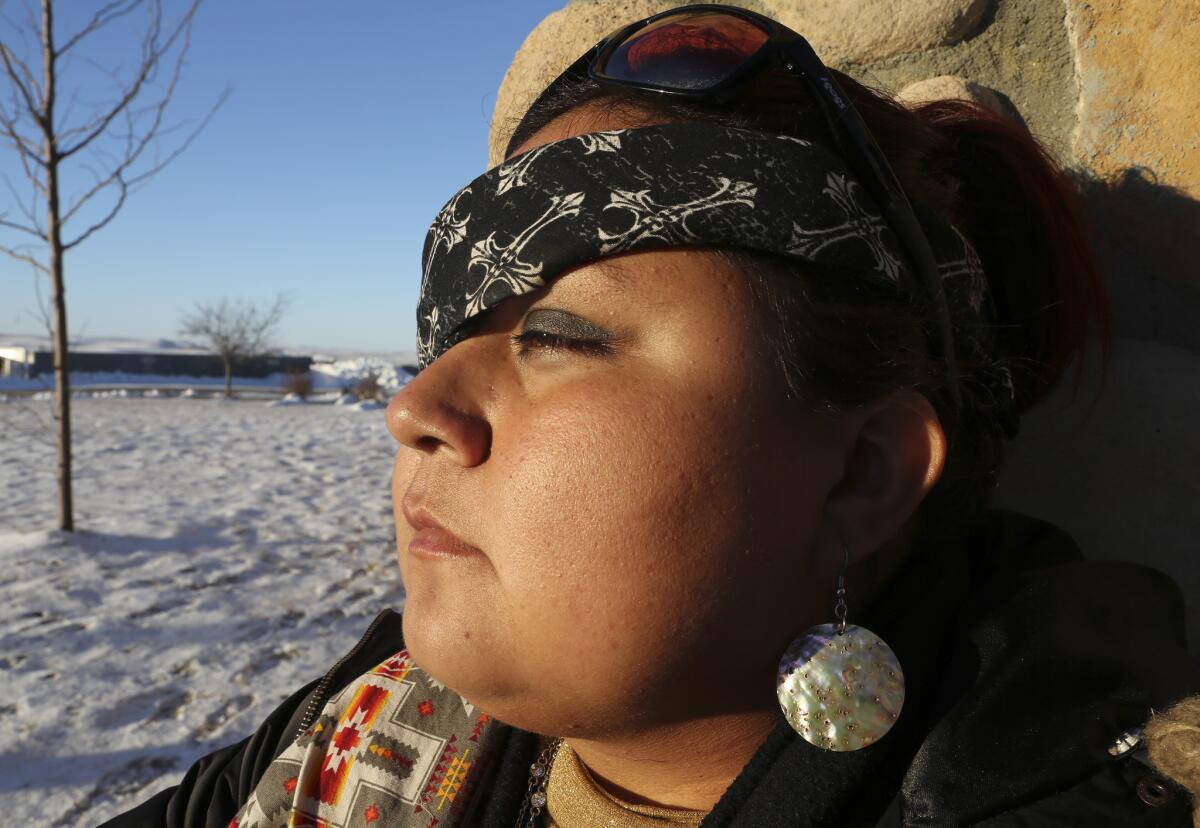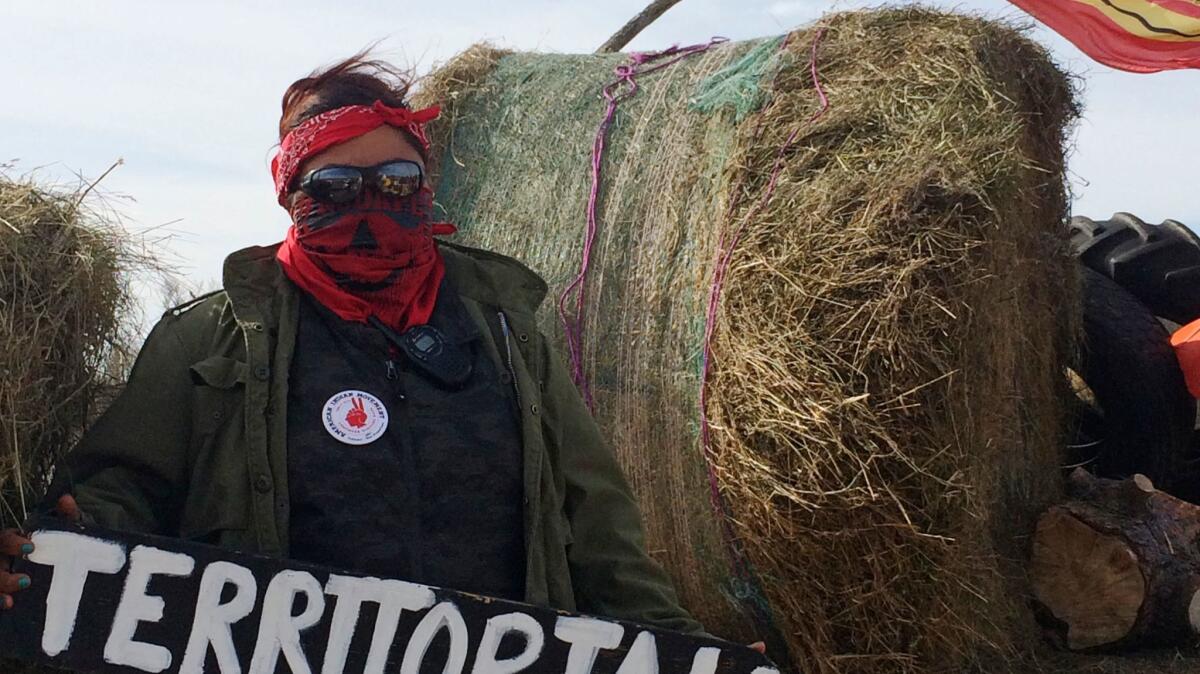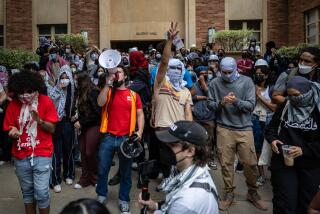Wounded on the front line at Standing Rock, a protester refuses to give up her fight

- Share via
Reporting from Along the Cannonball River, N.D. — On the night Vanessa Dundon was shot in the eye, she was on the front lines looking up at a phalanx of police.
It was after sundown on a cold night at the Backwater Bridge at the edge of the Standing Rock Sioux Reservation. Dundon, 31, a Navajo and mother of four, had arrived two months earlier to join thousands of others in their battle against the Dakota Access pipeline.
Working security for the pipeline resisters, Dundon trailed a group of men as they approached two burnt-out trucks, abandoned on the bridge during a chaotic day of mass protest and arrests. Now pipeline foes wanted to clear them and open the road for emergency vehicles.
The men moved onto the bridge. Police in riot gear fired tear gas canisters and rubber bullets from behind barbed wire. As Dundon took cover, she heard a woman yelling for help. She looked up. A flaming canister was headed her way. It was too late to duck.
“I knew it was going to hit me,” Dundon recalled later. “I just had to embrace it. I figured, it’s coming. Just got to take it.”
Dundon closed her eyes.
::
Dundon’s injury is one of the worst in the confrontation between police and those who’ve been gathered here for months to protest an advancing $3.8-billion, 1,172-mile pipeline. Hours after Dundon was injured, 21-year-old Sophia Wilansky, a recent graduate of Williams College, nearly had her left arm blown off by an explosive device.
Dundon faced obstacles at every turn as she sought medical help, but Wilansky was flown to a Minneapolis hospital in the hours after the explosion. And Dundon’s injury received a fraction of the attention given to journalist Erin Schrode, whose Facebook post of her injury from a rubber bullet received nearly 2.5 million views.
“It’s because they’re white,” said Chat Bobtail Bear, who was shot in the skull with a rubber bullet on the bridge shortly after Wilansky was hurt. He said he suffered severe bleeding from a wound that required seven staples to close. His injury also received little attention.
Wilansky recognized the disparity in a recent Facebook post. “I think that I received a disproportionate amount of money because I’m white,” Wilansky wrote. She offered to donate some of the funds she has received to lesser-known victims of police violence.
::
Dundon grew up in White Cone, Ariz., a high-desert community in the heart of the Navajo reservation, just south of the Hopi mesas. She was raised traditionally, surrounded by ceremony and the Navajo creed, “Walk in beauty.” “We have a saying, ‘Excuse my beauty!’” Dundon said, smiling. “I say it a lot.”
Last summer she heard about members of some 300 tribes who had gathered on the North Dakota prairie to fight the “black snake”: the winding pipeline. But it wasn’t until September when she saw a video of dogs from a pipeline security team biting protesters that she decided to join them. She found a ride and traveled north to Standing Rock.

As weeks passed, Dundon’s commitment grew deeper, her political awareness sharper. She swapped her skirts and moccasins for the Marine and Army uniforms her veteran sisters had brought her from Arizona. Her cousin named her “Adzaan Dezbah,” or “Lady Going to War.”
Determined to be more than just a spectator, she joined the American Indian Movement and became a security dispatcher and first responder on the front lines. Her code name was “Sioux Z.” On the front lines she would burn bundles of cedar and white sage, coaxing the smoke in the direction of the police, praying for them. “Excuse my beauty!” she would yell.
::
The flaming tear gas canister struck Dundon directly in her right eye. Instinctively she covered it with a bandana. She tried to run but almost immediately felt a rubber bullet pierce her skin. She fell. “O ma key ya po!” she yelled in Lakota. “Help me!” Dundon closed her eyes as a man and a woman dragged her toward safety.
“Is my eyeball hanging out?” she asked them. No, they told her, you’re just bleeding a lot.
But Dundon’s eye had been damaged, and in the crucial hours she had to save it, she found herself in a healthcare nightmare.
After camp medics applied sutures to halt the bleeding, a Standing Rock ambulance took her to a clinic in Mandan, an hour’s drive away. As she waited for attention, Dundon said, she overheard nurses talking about a Native man who’d been injured on the bridge. “That’s what he gets,” one of them said.
An hour later a doctor arrived and gave her stitches. He told her she needed to see a retina specialist immediately, but there were only three in the state. He recommended one in Fargo, 200 miles east. But they were unavailable over the Thanksgiving holiday.
The next day, Dundon went to a retina clinic in Mandan. Clerks there refused to accept her Indian Health Service insurance card from Arizona. “We can’t help you,” Dundon recalled them telling her. She called her mother, trying to connect the clinic with her Arizona benefits coordinator. “This is an emergency. This is 72 hours to save my eye. They wouldn’t treat me unless I had cash.”
I don’t know what I ever did to Morton County.
— Vanessa Dundon
Desperate for money, she returned to camp, where a drum group sang and a woman danced for her at the sacred fire. They raised $743 for her.
Her cousin then drove her four hours to Fargo, where she checked into an emergency room. But there was so much bleeding in her eye that it was impossible to determine the extent of the damage, she said. The next day, an ophthalmologist told her she probably had a detached retina.
Finally, five days after being injured, she had an appointment with a specialist in Minneapolis,a 3 ½-hour drive. She was told there was only a 5% chance she would see again out of her right eye.
“Seventy-two hours,” she later said dejectedly. “That’s all I had.”
::
Dundon is now the lead plaintiff in a civil rights class-action lawsuit filed in federal court against North Dakota police officials, alleging excessive force in “an increasingly violent campaign … to suppress and chill plaintiffs’ constitutionally protected rights.”
“I don’t know what I ever did to Morton County,” Dundon said. “The fact is I’m a water protector. I’m on the front lines. I am very passionate. But I’m not up there as an agitator.”
Morton County officials would not comment specifically on Dundon’s case because of the lawsuit. However, they have consistently defended police tactics. “Dakotans should be proud of law enforcement and the professionalism they have demonstrated throughout this ordeal,” said Cody Schulz, chairman of the Morton County Commission. “These protesters are now grasping at straws, using the court system to make false accusations against officers.”
Duncan said her anger goes far beyond the police.
Injured, she was unable to get the quick medical help she needed. Her health insurance, she said, “wasn’t good enough for me to get flown to Minneapolis. I had to make my way myself.”
Wilansky, in her offer to share medical funds, addressed the equity issue head on.
“I’m sure a lot of people feel the same way,” she said in her Facebook post. “We can’t fix the pathetically unequal and unjust healthcare system overnight, but we can look after each other in these extraordinary times.”
ALSO
Storm soaks Southern California; LAX jammed
The long and complicated road to understanding Jeff Sessions and matters of race
More to Read
Sign up for Essential California
The most important California stories and recommendations in your inbox every morning.
You may occasionally receive promotional content from the Los Angeles Times.










